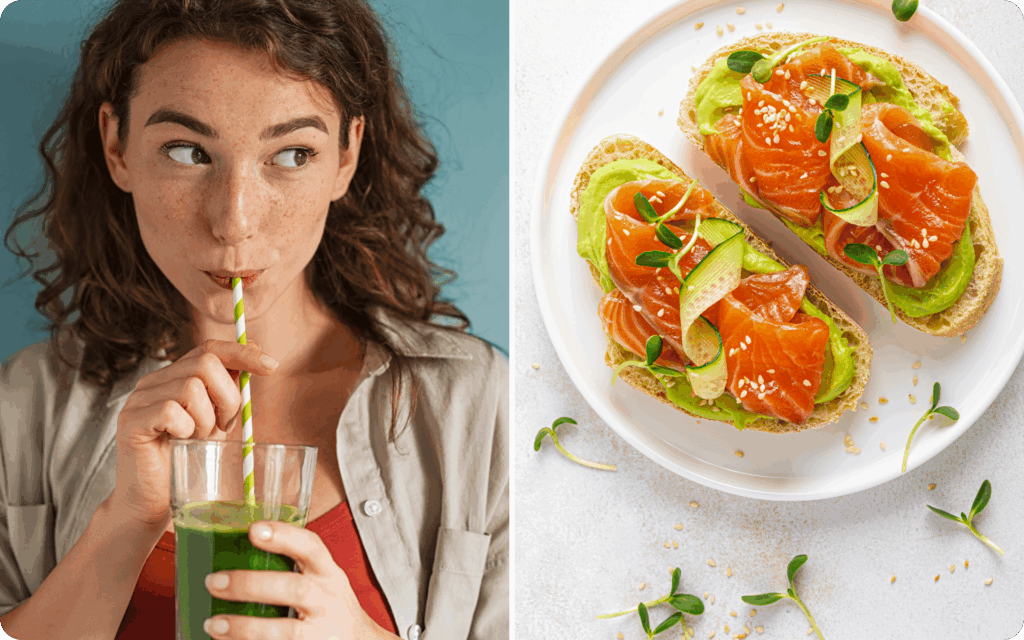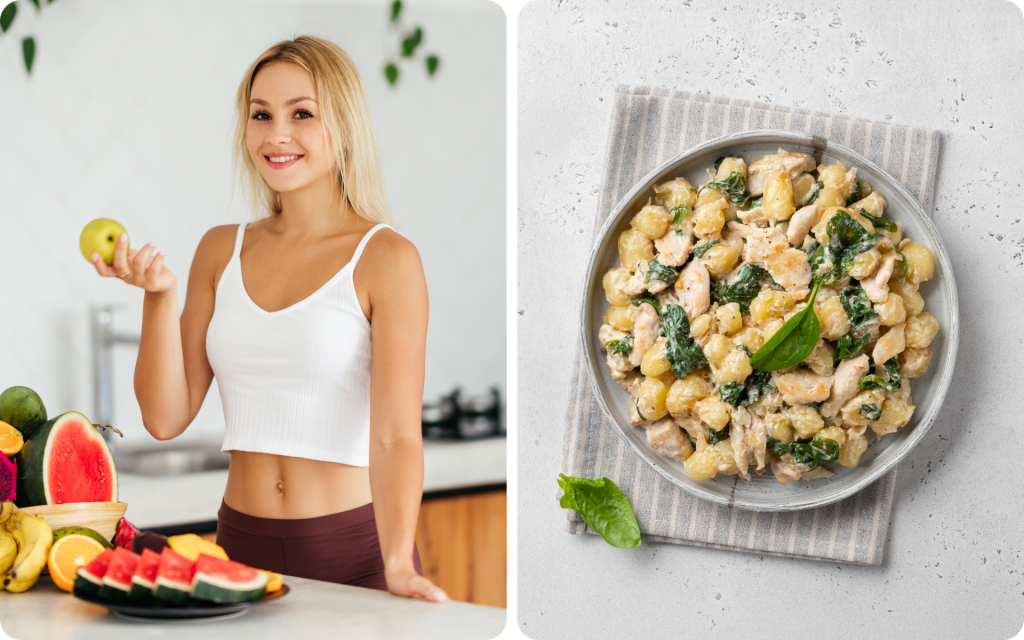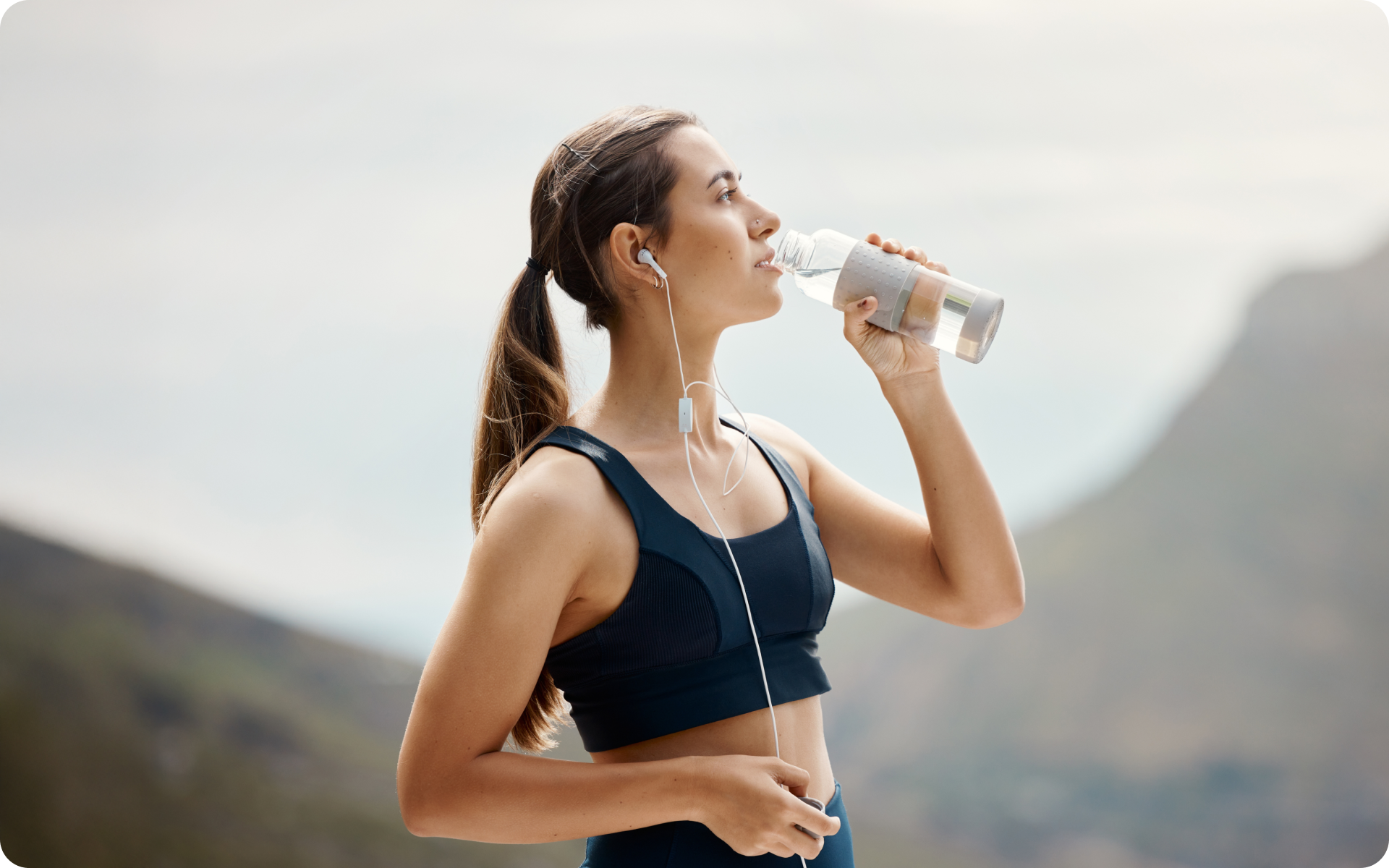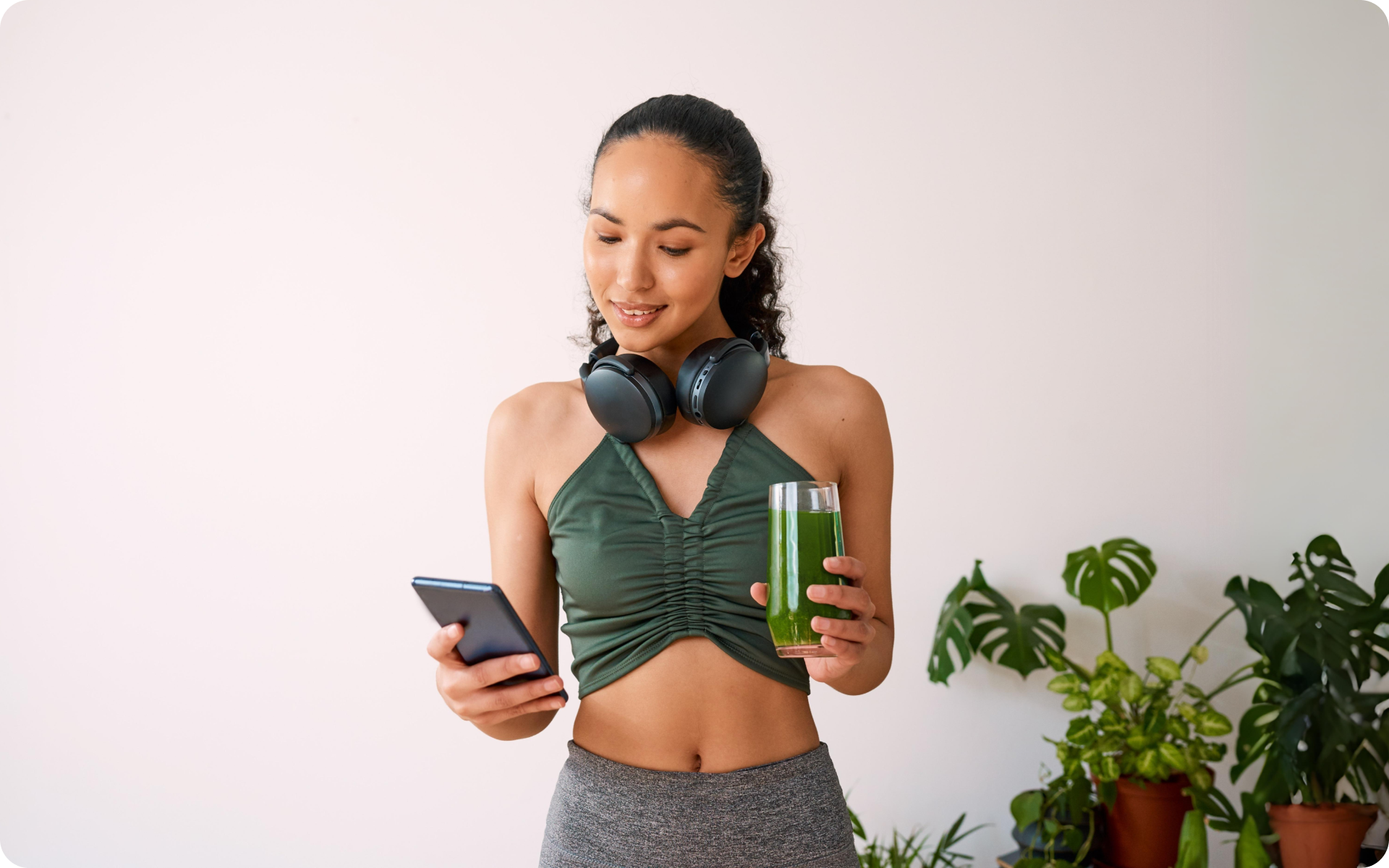According to scientific research and industry experts, fasting is an inextricable feature of human history and culture. For millennia, humans have practiced abstinence from food, drink, or both for health, ritualistic, religious, or ethical purposes (1, 2).
Intermittent fasting is a type of fasting that involves cycling between periods of voluntary fasting and periods of eating. This practice has gained popularity in the fitness and nutrition spaces due to its purported benefits, which range from weight reduction and management to lowering the risk of diabetes, cardiovascular disease, cancers, and neurological disorders (3, 4).
When practicing intermittent fasting, what you eat and how much you eat affect whether and how soon you see positive results. But what should you eat? Read on to learn about the best meals for intermittent fasting.
What Are The Best Meals For Intermittent Fasting?
The best meals for intermittent fasting are balanced and made from mostly nutrient-rich foods. According to research, such foods not only provide vitamins and minerals for relatively fewer calories, but health experts note that nutrient-rich foods help protect against abdominal obesity and high BMI, as well as reduce the risk of cardiovascular disease, diabetes, and all-cause mortality (5, 6, 7).
Which Food Is Best Food In Intermittent Fasting?
As seen above, nutrient-dense foods are among your best options for intermittent fasting. But what are they exactly?
Here are the food groups to include in your intermittent fasting diet chart for weight loss and improved health:
Lean Protein
Lean protein is ideal for intermittent fasting meals, as it helps control appetite (8, 9) and reduces your daily calorie intake. Studies done on high protein diets also show that consuming higher intakes of this macronutrient (such as 1.2 g to 1.6 g per kg of body weight per day) not only helps preserve muscle during weight loss and aging, but it can also be beneficial for building new muscle (10, 11, 12).
The best lean protein options include animal products such as eggs, fish and other seafood, skinless poultry, as well as lean cuts of beef and low-fat dairy.
Plant-based protein options, such as beans and legumes, soy products like tofu and tempeh, and nuts and seeds, are also excellent sources of lean protein.
When it comes to weight loss, progress is made by inches, not miles, so it’s much harder to track and a lot easier to give up. The BetterMe: Health Coaching app is your personal trainer, nutritionist, and support system all in one. Start using our app to stay on track and hold yourself accountable!
Whole Grains
Whole grains have been shown to aid in weight loss and weight management.
Researchers suggest that this could be due to factors such as (13):
- High fiber content in whole grains, which helps with satiety, thus helping with calorie restriction
- Polyphenols that may help boost your metabolism by preventing the maturation of fat cells
- Sufficient zinc and magnesium content that helps with the increase of fat-free mass and decrease of fat mass, and more
Whole grain examples for intermittent fasting weight loss goals can include:
- Oats
- Millet
- Quinoa
- Buckwheat
- Hulled barley
- Brown and wild rice
- Whole wheat products
Healthy Fats
Contrary to popular opinion, fat is not the enemy of weight loss or a healthy diet.
Choosing the right types of fats can help you maintain a balanced diet, which is not only essential for weight loss but also beneficial for your health (14, 15).
Sources of healthy fats include:
- Avocados
- Fatty fish like salmon, herring, trout, and mackerel.
- Oils like olive oil, rapeseed (canola) oil, sunflower oil, and other vegetable oils
- Nuts and seeds, e.g., walnuts, almonds, pecans, macadamia nuts, hazelnuts, pistachios, as well as chia seeds, flax seeds, and pumpkin seeds.
Fruits & Vegetables
Multiple studies agree that increasing your intake of fruits and vegetables helps optimize your health and reduce the risk of chronic illnesses and obesity (16, 17).
When intermittent fasting, ensure that you consume a variety of fruits and vegetables, such as:
- Leafy greens
- Bell peppers
- Pineapples
- Tomatoes
- Cucumbers
- Watermelon
- Peaches
- Brocoli
- Carrots
- Apples
Try to shop in season and consume what’s readily available to you.
Frozen fruits and vegetables are also great, convenient options that are just as nutritious and fresh.
Check out our 7-day meal plan for intermittent fasting to see how to use the above foods for your weekly meal prep.
Read more: Fasting for Beginners: A Healthy Approach
What Are The Rules For Intermittent Fasting?
Unlike other weight loss plans and diets, intermittent fasting doesn’t have as many rules.
There are primarily 2 intermittent fasting rules:
- Do not eat during the fasting window.
- The only beverages you can drink during the fasting window are plain (still or sparkling) water, as well as unsweetened tea or black coffee.
Everything else is up to you.
However, if you want to see good results from this plan, some things you should take into consideration include:
1. What You Eat
As mentioned above, nutrient-rich foods will always be the better option.
Ultra-processed and calorie-dense foods may be convenient and delicious, but they are likely to sabotage your efforts rather than help them.
Here is an intermittent fasting meal plan example, to show you how to eat while on this program.
2. How Much You Eat
Intermittent fasting doesn’t put a restriction on your calorie intake.
However, if you wish to shed those extra pounds, research suggests that an energy deficit is the most essential factor in weight loss. Reduce your daily average calorie intake by 500 – 750 kcal for optimal results (18).
3. Choose An Intermittent Fasting (IF) Plan That Best Suits You
The most popular IF plans include:
- Time-restricted feeding: This involves limiting food intake to a specific window of time each day. For example, the 16:8 plan limits your feeding window to 8 hours of the day and requires fasting for 16 hours.
- The 5:2 diet: This variation involves eating a regular, healthy diet for five days of the week and restricting calories to 500 kcal for women and 600 kcal for men on two non-consecutive days.
- The alternate-day fasting meal plan: With this variation, you fast on one day, limiting your calorie intake to approximately 500 calories, which is about 25% of your regular calorie intake, and then eat normally on the next day.
All variations have their pros and cons. When choosing the best intermittent fasting for weight loss options we recommend trying any of the above-mentioned options and experimenting with them to make the best decision that suits you and your lifestyle.
4. Be Patient
IF is not a miracle weight loss option.
Like everything else, it will take some time, possibly a few weeks, before seeing results.
Remain consistent, and change will come.
What Are You Allowed To Eat In Intermittent Fasting?
While practicing intermittent fasting, especially time-restricted eating, you are not allowed to eat anything during the fasting window. The only things you can consume during this time are beverages, specifically water and unsweetened tea or coffee.
Once the feeding window opens, you can consume whichever foods and drinks you wish till the window closes again. With that said, it is best to keep the foods and drinks consumed during this window as healthy as possible and to consume them as balanced meals within the recommended calorie intake for your goal.
Doing so helps prevent overeating, which could sabotage your efforts and lead to weight gain and other obesity-related health risks.
Here are some intermittent fasting recipes to give you meal ideas for your eating window.
What To Avoid During Intermittent Fasting
You should avoid all food during the fasting window (only drink calorie-free drinks during this timeframe). It is essential to note that there is no strict rule on the foods to avoid while intermittent fasting once the eating window opens.
However, most experts recommend avoiding or limiting:
- Alcohol
- Ultra-processed foods
- Sugary drinks and treats
- Refined carbohydrates
Scientific studies on these suggest that, when overconsumed, they have adverse effects on your health and can increase your risk of chronic illnesses, and even negatively affect your mental health (19, 20, 21, 22).
Which Meal Is Best To Skip During Intermittent Fasting?
The best meal to skip while fasting depends on individual preferences and routines.
Some people might find it easier to skip breakfast, while others may find that foregoing dinner is a more manageable option. Simply choose the option that best suits your life and daily routines.
Read more: What Are Prolific Keto Fasting Hours?
What Are The Disadvantages Of Intermittent Fasting?
Before your body adjusts to IF, you may find yourself battling cravings, headaches, irritability, mood swings, or even lightheadedness. These symptoms are usually due to hunger, since you are going longer than usual without calories.
Drinking water and unsweetened coffee/tea during the fasting window can help you hold over and reduce these side effects until the eating window opens.
Once your body acustomizes itself to your intermittent fasting cycle, chances are that these side effects will fade. With that said, always pay attention to your body.
If the side effects are too much, break your fast and eat something. As mentioned earlier, there is no one-size-fits-all type of intermittent fasting plan. Listen to your body and adjust accordingly.
BetterMe: Health Coaching app helps you achieve your body goals with ease and efficiency by helping to choose proper meal plans and effective workouts. Start using our app and you will see good results in a short time.
Note that:
Health professionals do not recommend intermittent fasting for the following demographics:
- Pregnant or breastfeeding women
- Children and teenagers
- Individuals with a history of eating disorders
- Anyone treating or managing diabetes who takes insulin. Intermittent fasting may be OK for some people with type 2 diabetes (23), depending on their medication regimen and their doctor’s recommendations, but it isn’t the case with type 1.
Some research says that IF might be helpful for those with type 1 diabetes, but the research is still limited.
Researchers state that it is imperative for individuals with type 1 diabetes who wish to try this program to be in frequent contact with their healthcare providers, particularly during the early stages of the diet (24).
Anyone with any type of diabetes or on any medication that lowers their blood sugar should speak to their doctor before attempting any type of fasting.
No, you cannot eat a banana while fasting, especially if you are doing time-restricted eating. However, if you are following the 5:2 diet or alternate-day fasting meal plan, bananas are okay on fasting days. Just be sure to log the calories so you don’t go over the allocated intake for the day. No, you cannot eat an avocado during the fasting window. Stick to water, and unsweetened coffee or tea. No, you can’t eat rice during fasting. Doing so will break your fast. There are no foods that are truly zero calories. All foods contain calories; however, some foods have far fewer than others. Examples of almost zero-calorie foods include cucumbers, lettuce, bell peppers, berries, and tomatoes.Frequently Asked Questions
Can I eat a banana while fasting?
Can I eat avocado while fasting?
Can I eat rice during fasting?
What are some zero-calorie foods?
The Bottom Line
The best meals for intermittent fasting are those that are high in nutrients.
Not only are they good for your health, but they will help you reach any weight loss goals that you may have. Stick to lean proteins, healthy fats, whole grains, and fruits and vegetables. In the same breath, be sure to avoid or limit refined carbohydrates, added sugars, alcohol, and ultra-processed foods.
DISCLAIMER:
This article is intended for general informational purposes only and does not serve to address individual circumstances. It is not a substitute for professional advice or help and should not be relied on for making any kind of decision-making. Any action taken as a direct or indirect result of the information in this article is entirely at your own risk and is your sole responsibility.
BetterMe, its content staff, and its medical advisors accept no responsibility for inaccuracies, errors, misstatements, inconsistencies, or omissions and specifically disclaim any liability, loss or risk, personal, professional or otherwise, which may be incurred as a consequence, directly or indirectly, of the use and/or application of any content.
You should always seek the advice of your physician or other qualified health provider with any questions you may have regarding a medical condition or your specific situation. Never disregard professional medical advice or delay seeking it because of BetterMe content. If you suspect or think you may have a medical emergency, call your doctor.
SOURCES:
- Fasting (n.d., britannica.com)
- Traditional and Medical Applications of Fasting (2022, mdpi.com)
- Research on intermittent fasting shows health benefits (2020, nia.nih.gov)
- Beneficial effects of intermittent fasting: a narrative review (2022, pmc.ncbi.nlm.nih.gov)
- The nutrient density approach to healthy eating: challenges and opportunities (2014, pmc.ncbi.nlm.nih.gov)
- Increased Intake of Foods with High Nutrient Density Can Help to Break the Intergenerational Cycle of Malnutrition and Obesity (2015, pmc.ncbi.nlm.nih.gov)
- The development of a dietary nutrient density educational tool and the investigation of its acceptance by Chinese residents from Henan province (2024, bmcpublichealth.biomedcentral.com)
- Effect of short- and long-term protein consumption on appetite and appetite-regulating gastrointestinal hormones, a systematic review and meta-analysis of randomized controlled trials (2020, sciencedirect.com)
- The role of protein in weight loss and maintenance (2015, pubmed.ncbi.nlm.nih.gov)
- Dietary Protein and Muscle Mass: Translating Science to Application and Health Benefit (2019, pmc.ncbi.nlm.nih.gov)
- Clinical Evidence and Mechanisms of High-Protein Diet-Induced Weight Loss (2020, pmc.ncbi.nlm.nih.gov)
- Systematic review and meta‐analysis of protein intake to support muscle mass and function in healthy adults (2022, pmc.ncbi.nlm.nih.gov)
- Weight loss induced by whole grain-rich diet is through a gut microbiota-independent mechanism (2020, pmc.ncbi.nlm.nih.gov)
- Fats, oils and heart health (2025, heartfoundation.org.au)
- Fat: the facts (2023, nhs.uk)
- Fruit and Vegetable Intake: Benefits and Progress of Nutrition Education Interventions- Narrative Review Article (2015, pmc.ncbi.nlm.nih.gov)
- Fruits, vegetables, and health: A comprehensive narrative, umbrella review of the science and recommendations for enhanced public policy to improve intake (2019, tandfonline.com)
- Optimal Diet Strategies for Weight Loss and Weight Loss Maintenance (2020, pmc.ncbi.nlm.nih.gov)
- ANALYSIS OF THE IMPACT OF CARBOHYDRATES ON HUMAN HEALTH AND DISEASE (2022, researchgate.net)
- Alcohol’s Effects on the Body (2025, niaaa.nih.gov)
- The Impact of Free Sugar on Human Health—A Narrative Review (2023, pmc.ncbi.nlm.nih.gov)
- Ultra-processed food exposure and adverse health outcomes: umbrella review of epidemiological meta-analyses (2024, bmj.com)
- Intermittent fasting for weight loss in people with type 2 diabetes (2023, nih.gov)
- Clinical potential of fasting in type 1 diabetes (2024, sciencedirect.com)














